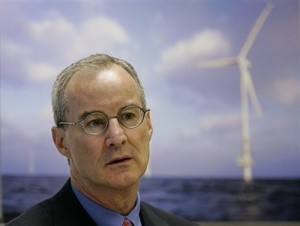
Tweet
![]()
On Friday, March 25,2011, Cape Wind LLC‘s CEO Jim Gordon spoke at Columbia University about the long delayed project. When he started the project, back in 2001, the Europeans were 10 years ahead of us. Today the Europeans are 20 years ahead of us, and the Chinese too are years ahead of us.
Mr. Gordon quoted Theodore Roosevelt, IV, as saying, “I live on the Cape. If we don’t do this, in 50 years the Cape will be under water.” Cape Cod’s highest point is about 300 feet above sea level so Mr. Roosevelt was exaggerating. His home may wind up under water, but at least some of the Cape will be one or more islands. Speaking of islands, Nantucket, which in 2006 had the highest median property values in Massachusetts, rises some 30 feet above sea level. If sea level rises 30 feet, Nantucket will get washed away.
Mr. Gordon said, “Cape Cod has the most polluted air in New England. When you harness the wind you get clean electricity: No arsenic, lead, mercury, thorium, uranium, or zinc or carbon dioxide like you get from burning coal. No barges of oil that can spill. No radioactive waste like you get from nuclear power. Last year we read about the coal mine disaster in West Virginia. Then the Deepwater Horizon. Now we’re reading about the disaster in Japan. With wind there is no possibility of a disaster, Zero.”
And, he added, “Fossil fuels are a finite resource. New England has neither coal, oil, or natural gas – but there is a tremendous amount of wind. When you factor in the costs of storms and sea level rise – you would think it’s a no-brainer.” The question is not “Can wind power provide base line capacity?” But “How can wind power provide base line capacity.”
Mr. Gordon told how during a trade mission to China, one of his engineers was grilled about wind power, offshore wind, engineering, costs, and siting. After the end of the grilling his hosts said “we read Cape Wind, by Wendy Williams and Robert Whitcomb. We would never allow that here.” In 2009 China built a 100 mw wind farm off the coast of Shanghai – completed the project quickly. By the end of 2010 they had 41.8 gigawatts of nameplate capacity wind power – enough for about 45 million Americans (wikipedia). Continue reading